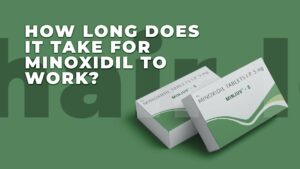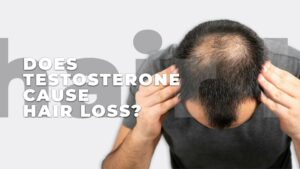One of the most dreaded things for men is hair thinning; this could be considered an early sign of male pattern baldness. Both men and women face receding hairline and hair thinning, but it is more common in men than in women. Hair thinning is common as men start aging. There could be several causes for hair thinning. It is important to notice these early signs and take steps that keep your head full of hair until it’s too late.
This article provides information on hair thinning, its causes, early signs, and treatment options to help you make an informed decision.
Contents
Causes of Hair Thinning

It is normal to lose about 100-150 strands of hair every day as the hair grows back, but sometimes the cycle falters, and you begin to lose hair rapidly with no signs of growing back. There are several reasons why your hairline could be receding or thinning. They could be
- Age: Most men experience hair loss with growing age; it is a natural part of aging. Hair follicles become damaged, and new hair doesn’t grow back. This leads to a receding hairline and hair loss.
- Genetics: Genetics plays an important role in hair health. It is known as androgenetic alopecia. Men with a history of baldness or receding hairline are more likely to follow the same pattern.
- Hormonal change: The growth of a hormone called Dihydrotestosterone (DHT) is linked to hair loss and thinning. It causes damage to hair follicles and shrinks them. An abundance of this hormone could result in hair thinning.
- Stress: It is the leading cause of hair loss. High levels of stress are related to hair loss. Taking care of your mental health might be a good way of dealing with hair loss. Practicing yoga or meditation can bring down your stress levels, thereby reducing your chance of hair loss.
- Lifestyle changes: People with stressful jobs or a hectic lifestyle that leaves no room for exercise or nutrition may experience faster hair loss. Smoking is also associated with rapid hair loss.
- Illness/medications: Suffering from life-threatening illnesses or side effects of certain medications could take a toll on your hair and lead to baldness or receding hairline.
- Telogen effluvium: a condition where a person sheds excessively due to stress or illness. It is not typically permanent, and with the aid of medication, it is reversible within six months.
Early Signs of Balding: How to tell if your hair is thinning?
Male pattern baldness doesn’t happen overnight and is a gradual process. Since it’s a gradual process, it is easy to miss out on early signs of hair thinning, but there are a few things you can look out for a while assessing your situation. Look out for these early signs of balding.
- Excessive shedding
If you lose more than 100-150 strands of hair daily, it is an early sign of male pattern baldness and deserves immediate attention. Approaching the problem immediately helps in controlling hair growth and preventing permanent damage.
- Visible changes
It is a sign if you notice visible changes in your appearance in mirrors and photos, where your hairline seems farther back or tapers from the corners. Over time, your hair feels different and doesn’t provide much coverage.
- Hair thinning
Hair loss occurs in different areas, and you experience bald patches resulting in a receding hairline. You start noticing hair appears thinner and damaged and exposes your scalp. It looks obviously visible in bright lighting, and the hair looks thinner than normal.
- Uneven hairline
Your previously symmetrical hairline starts appearing uneven; if uncertain, take pictures to confirm. This could be an early sign of balding; it could cause asymmetrical hair loss leading you to go bald from one side.
- Hair takes longer to grow back
Male pattern baldness shortens the hair growth cycle; this usually happens as men grow older. Normally you regain the hair you’ve lost after a couple of months. But you notice your cycle stopping leading to no hair gain, or even when hair appears, it feels thinner than usual; it is a sign of baldness.
- Receding hairline
A receding hairline is a very prominent sign of balding or hair thinning; your previously even hairline feels uneven, and you notice it traveling farther back. Usually, you notice a U-shaped hairline, and your hair doesn’t provide much coverage anymore.
- Hair feels different
When you brush your hand through your hair, it doesn’t feel very dense, and hair appears thinner than it normally should. You start noticing hair appears damaged and exposes some of your scalp. This is very easy to overlook, as thinning hair doesn’t necessarily mean you’re going bald. However, consult your doctor soon if you notice excessive hair loss and sparse spots on your head.
- Bald patches
Excessive hair fall, if not noticed earlier, can result in bald patches, usually on the top of your head or the sides. Your scalp might feel itchy or painful before it falls out. This is usually due to alopecia areata, but it is mostly temporary. You can regain your hair with the aid of medication or other treatment options.
Normal Hairline v/s Receding Hairline in Men
A normalhairline does not go farther back than an inch on your forehead, and the hairline remains defined. There is no excessive hair loss or hair thinning. It is a normal part of aging.
While a receding hairline will travel farther than an inch on your forehead, and it travels at a faster pace. You might also experience bald patches and hairline at the temples receding farther back than usual.
Receding Hairline and Hair Thinning in Women

Women experience hair loss differently than men. It is rare for women to go completely bald or have a receding hairline. They usually experience excessive hair loss and hair thinning. There are two conditions that might cause a receding hairline in women.
- Traction Alopecia: This is caused by the excessive pulling back of the hair. If you repeatedly tie your hair in tight ponytails, buns, or braids, you could experience traction alopecia. However, this condition is reversible by letting your hair relax and keeping it out of tight hairstyles.
- Frontal Fibrosing Alopecia: This condition is characterized by a slow progression of hair loss and scarring of the scalp.
Diagnosis
Hair loss is a serious issue, but it is not to be mistaken for hair shedding, which is completely normal and happens daily. It is normal to shed 100 to 150 strands of hair daily. However, if you experience excessive hair loss, balding, or spots, you should immediately seek medical help. Hair loss can be assessed by a dermatologist. You will be asked about your family history, and a “pull test” might be used. For better, accurate results, your dermatologist might also do a scalp biopsy and run some blood tests to evaluate scalp health and rule out medical issues.
The quicker you address the symptoms, the easier it will be to prevent permanent damage. However, if your hair fall is minimal, some at-home remedies can prove to be useful. To improve your hair health, it is important to stay consistent with your efforts. Results take a few months to be noticeable, so don’t lose hope.
Treatment Options
If you face hair loss, it is time to look for treatment options that suit you best. Here are a few options you could discuss with your doctor.
- Medication
The easiest, most convenient way of dealing with hair loss is to start with medication. Medications like minoxidil and finasteride are scientifically backed to improve the quality and volume of hair. These medications stimulate hair growth by increasing blood flow and reducing DHT levels.
- Lifestyle changes
Making small, simple lifestyle changes can enhance hair growth by increasing blood flow and oxygen to your hair. These changes can include adding more protein to your diet or working out 3-5 times a week.
- DHT-blocking hair products
The hormone DHT is the main culprit for hair thinning. There are many hair products available that block the production of DHT and minimize the damage caused to your hair follicles. These products might not be as effective as medications like minoxidil or finasteride, but they have proven to minimize hair loss to a small extent.
- Acupuncture
Acupuncture has been used as a medical therapy for hair loss for years. Acupuncture targets specific points in your body that stimulate hair follicles and encourage growth. However, these claims are not backed up by research in treating male or female pattern baldness.
- Micro-needling
Micro-needling is similar to acupuncture. It is a cosmetic treatment that includes a device with hundreds of tiny needles. It is believed to induce stem cells in the hair follicles that promote hair growth. When paired with medications like Minoxidil, it can show significant results. Micro-needling helps absorb these medications quicker, making them more effective.
- PRP therapy
PRP (platelet-rich plasma) therapy is a procedure where they take a small amount of your blood from the arms is spun through a centrifuge to concentrate the platelet-rich plasma in the scalp. The idea is to increase the concentration of specific bio proteins or hormones in an area to speed up hair growth.
- Massage your scalp
Massaging your scalp daily with essential oils increases the blood flow to the scalp. This strengthens the hair follicles and makes them susceptible to future damage. Repeat this every day for at least 5 mins for better results.
- Vitamins and supplements
If you face hair loss due to nutritional deficiencies, it is time to turn to vitamins and supplements. When you lack certain vitamins and nutrients that help in hair growth, your hair becomes susceptible to breakage. These vitamins and supplements help in hair restoration. They provide your body with the necessary nutrients for growth, thus strengthening your hair follicles.
- Low-level light therapy
LLLT is a treatment that uses laser light to stimulate hair growth and strengthen hair follicles. It helps combat hair loss and improve your hair health. It also improves the volume and appearance of your hair, giving it a more natural look. It is FDA-approved and has no side effects. The therapy is painless and is proven to be beneficial to many patients suffering from hair loss.
- Hair transplant
A hair transplant might be the last resort to eliminate hair loss. It involves taking small sections from the back of your head to areas where growth is halted. It is an effective and permanent solution for a receding hairline. This is a safe surgery and could last between 4-6 hours. Hair transplant surgery gives a natural look, unlike hair plugs.
Preventive measures

- Identify the problem
Is it your lifestyle or the effect of a certain medication? Is it your hair care routine or your diet? Identifying the root cause of your problem is half battle won. When you have successfully identified your problem, it is easier to manage and rectify hair loss.
- Avoid heat
We often style our hair to look amazing on a daily basis, but that takes a toll on your hair follicles, leaving them dry and vulnerable to damage. Prolonged exposure to heat can make them brittle and permanently damage your hair over time.
- Nutrition
Healthy hair begins with an amazing diet. A healthy, well-balanced diet with adequate hydration is closely related to having great hair. A diet rich in B12, zinc, vitamin D could significantly reduce hair loss.
- Quit smoking
Smoking has many evils, one of them being hair loss. It can prematurely age your hair follicles leaving them vulnerable to damage.
Takeaway
Our article guides you through the signs, causes, and treatment options for hair loss and male pattern baldness. Noticing early signs is crucial to prevent permanent hair loss and reverse your condition. Consult your doctor if you see any signs, and seek advice on available treatment options.
References
- Androgenetic alopecia. (2019).
ghr.nlm.nih.gov/condition/androgenetic-alopecia - Diagnosing hair loss. (n.d.).
nyulangone.org/conditions/hair-loss/diagnosis - Do you have hair loss or hair shedding? (2008).
aad.org/hair-shedding - Egger A, et al. (2020). Advances in stem cell-based therapy for hair loss.
ncbi.nlm.nih.gov/pmc/articles/PMC7508456/ - Gupta M, et al. (2016). Classifications of patterned hair loss: A review.
jcasonline.com/article.asp?issn=0974-2077;year=2016;volume=9;issue=1;spage=3;epage=12;aulast=Gupta - Hair loss: Diagnosis and treatment. (n.d.).
aad.org/public/diseases/hair-loss/treatment/diagnosis-treat - Hair loss: Signs and symptoms. (n.d.).
aad.org/hair-loss-begins - Hair loss: Who gets and causes. (n.d.).
aad.org/public/diseases/hair-loss/causes/18-causes - Lee WS, et al. (2012). Characteristics of androgenetic alopecia in Asian.
ncbi.nlm.nih.gov/pmc/articles/PMC3412231/ - Zhou Z, et al. (2019). The efficacy and safety of dutasteride compared with finasteride in treating men with androgenetic alopecia: A systematic review and meta-analysis. dovepress.com/the-efficacy-and-safety-of-dutasteride-compared-with-finasteride-in-tr-peer-reviewed-fulltext-article-CIA










5 comments on “First Signs of Hair Thinning: Causes, Signs, and Treatment Options”
casino games
This website, you can find a wide selection of casino slots from famous studios.
Players can try out classic slots as well as modern video slots with high-quality visuals and interactive gameplay.
Even if you’re new or an experienced player, there’s something for everyone.
casino
Each title are instantly accessible anytime and compatible with PCs and mobile devices alike.
All games run in your browser, so you can jump into the action right away.
Site navigation is easy to use, making it quick to explore new games.
Register now, and enjoy the thrill of casino games!
www.clocksforlife.com
This online store offers a wide selection of home timepieces for your interior.
You can browse urban and traditional styles to enhance your home.
Each piece is curated for its craftsmanship and functionality.
Whether you’re decorating a creative workspace, there’s always a fitting clock waiting for you.
best ihome id91bzc 30 pin clocks
Our catalog is regularly expanded with fresh designs.
We ensure customer satisfaction, so your order is always in professional processing.
Start your journey to timeless elegance with just a few clicks.
www.clocksforlife.com
Here offers a great variety of decorative timepieces for any space.
You can browse contemporary and traditional styles to match your home.
Each piece is hand-picked for its design quality and reliable performance.
Whether you’re decorating a stylish living room, there’s always a matching clock waiting for you.
best design digital alarm clocks
The collection is regularly refreshed with fresh designs.
We prioritize customer satisfaction, so your order is always in safe hands.
Start your journey to better decor with just a few clicks.
Michealblige
The site makes available many types of pharmaceuticals for online purchase.
Anyone can quickly get treatments from anywhere.
Our catalog includes everyday solutions and more specific prescriptions.
All products is provided by verified suppliers.
https://community.alteryx.com/t5/user/viewprofilepage/user-id/573786
We prioritize customer safety, with data protection and timely service.
Whether you’re treating a cold, you’ll find affordable choices here.
Visit the store today and get reliable support.
Francie Cosgriff
Hello! I’ve been reading your web site for some time now and finally got the bravery to go ahead and give you a shout out from Atascocita Tx! Just wanted to say keep up the excellent job!